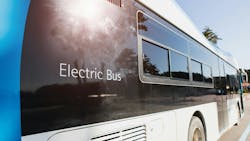RABA tackles a big transition as it plans for a zero-emissions future
Transit agencies across the U.S. are exploring a shift to zero-emission buses as they respond to a mix of pressures, including government clean-air mandates, rising fuel costs, aging fleets and community demand for less pollution and quieter streets. From large metropolitan systems to smaller rural providers, the push toward battery-electric buses (BEBs) and hydrogen fuel cell buses (FCEBs) reflects a growing recognition that the future of public transit can be cleaner and more sustainable.
One example is the Redding Area Bus Authority (RABA) in Northern California. Serving Shasta County with both urban and rural routes, RABA is preparing to comply with California’s Innovative Clean Transit (ICT) rule, which requires all agencies in the state to operate a 100% zero-emissions fleet by 2040. RABA completed a required rollout plan for an electric fleet, but agency staff quickly realized that the high-level framework left unanswered questions and potential challenges. Which routes could realistically be electrified? How should charging or fueling infrastructure be phased in? And what would different technology choices mean for long-term operating costs?
A deeper analysis was needed, one that allowed RABA to move beyond compliance and address the practical realities of operating an electric fleet in a challenging geography and with limited resources.
Evaluating technology options
The agency’s analysis focused on comparing BEBs and FCEBs, each with distinct tradeoffs. BEBs can be supported by Redding Electric Utility’s relatively predictable electricity rates, but they face range limitations on longer, hilly routes, as well as during cold weather. FCEBs offer greater range and faster fueling, but the region currently lacks hydrogen supply infrastructure, making them dependent on costly and uncertain fuel deliveries. Hydrogen prices at California agencies have ranged from $8 to more than $10 per kilogram, well above the $5–$7 target for long-term viability.
To answer these questions, RABA used block-level route modeling and energy simulations, testing different technology mixes against real-world operating conditions. Four alternatives were evaluated, from an all-electric fleet to blended approaches that assign fuel cell buses to the longest or most demanding routes. The modeling also accounted for charging needs at the downtown Redding Transit Center, where short layover times limit opportunities to recharge, and for the significant power demands that could arise if many buses require charging simultaneously.
Preparing for costs, infrastructure and community benefits
RABA’s transition planning also considered capital and operating costs, workforce training and infrastructure requirements, ranging from depot chargers to high-power overhead pantograph systems at the transit center. The economic analysis confirmed what many agencies face: Upfront costs for vehicles and infrastructure will be higher than for conventional fleets, but savings from lower fuel and maintenance expenses could offset those costs over time. The lack of a local hydrogen supply chain, however, remains a major uncertainty.
Stakeholder engagement has been a critical part of the process for RABA. Early meetings brought together Redding transit users, local governments and regional utilities to discuss vehicle technology, infrastructure siting and funding strategies. Community voices, particularly from transit-dependent populations, emphasized the importance of cleaner air and reliable service as part of the transition.
The final Zero-Emission Bus Implementation Plan will provide RABA with a detailed procurement schedule, infrastructure concepts, cost-benefit projections and recommendations for workforce development. For other small and rural transit systems across the country, RABA’s experience underscores the importance of going beyond compliance. Leveraging detailed modeling, considering realistic cost assessments and engaging local residents and stakeholders are all essential to building a zero-emissions future that is not only feasible, but responsive to community needs.
Four takeaways for agencies going electric
- Model at the route level. Block-by-block energy modeling helps identify which routes can reliably be served by BEBs versus those that may require hydrogen or alternative strategies.
- Plan for infrastructure early. Depot upgrades, charging hubs and potential high-power systems must be mapped against utility capacity and route timing to avoid costly surprises.
- Expect cost tradeoffs. Upfront investments will be higher, but long-term fuel and maintenance savings can help balance the ledger. Hydrogen pricing and supply remain volatile and should be factored into any risk assessment.
- Engage stakeholders throughout. Bringing in utility partners, local governments and community members early ensures solutions are grounded in regional realities and build public support for the transition.
About the Author

Bincy Koshy
Transportation Planner and Engineer, DKS Associates
Bincy Koshy is a transportation planner and engineer at DKS Associates.

Mike Usen
Principal and National Director for electromobility, DKS Associates.
Mike Usen is principal and national director for electromobility at DKS Associates.

Steffen Coenen
Electromobility Engineering Associate, DKS Associates
Steffen Coenen is an electromobility engineering associate at DKS Associates.
